11 Best Native Plants for Pittsburgh
BY CECILIA ACEVEDO | APRIL 1ST, 2023 | LANDSCAPING, PENNSYLVANIA, PITTSBURGHSteel City is known for its cold winters and hot summers. So, when dreaming about your perfect backyard landscape, consider the best native plants for Pittsburgh that can withstand the change of seasons. By choosing native species, you save time and money and help the ecosystem.
There are several advantages of planting native species in your Pittsburgh backyard:
- Native plants fortify the ecosystem by providing food and habitats for native wildlife.
- Native trees and plants are essential for clean air and water, capturing stormwater runoff, preventing erosion, and mitigating temperature extremes.
- Many native plants require little to no fertilizer.
Native plants help to promote and preserve Pittsburgh’s ecosystem. Consider these 10 native plants for Pittsburgh to create a stunning backyard.
In this article, we’ll see:
- 11 Native Plants for Your Pittsburgh Yard
- How to Choose Native Plants for Your Pittsburgh Landscape
- FAQ About Native Pittsburgh Plants
- Where to Find Native Plants in Pittsburgh
11 Native Plants for Your Pittsburgh Yard
1. Eastern Redbud (Cercis canadensis)
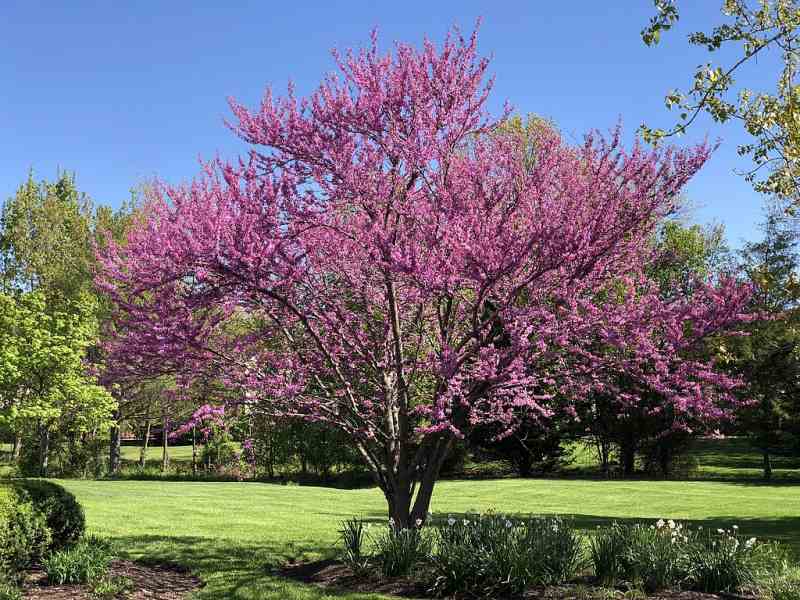
Photo Credit: Famartin / Wikimedia Commons / CC BY-SA 4.0
The eastern redbud is a deciduous tree that typically grows 20 to 30 feet tall. The tree is known for its striking pink or purple flowers, which bloom in early spring before the leaves emerge. It is a famous ornamental tree because of its early spring blooms and attractive heart-shaped leaves ranging from green to blue-green. In the fall, the leaves turn yellow before dropping from the tree. The bark of the eastern redbud is dark brown and slightly rough.
Like many plants, it is susceptible to insect pests and diseases like leafhoppers, caterpillars, borers, japanese beetles, treehoppers, scales, and webworms. Possible diseases that can affect it include canker, dieback, leaf spots, verticillium wilt, blights, and mildew. However, with proper care, the eastern redbuck can be a beautiful and resilient addition to a landscape.
Plant type: Tree
USDA Hardiness Zone: 4 to 9
Sun: Full sun or partial shade.
Soil: Any moist, well-draining, nutrient-rich soil
Duration: Deciduous perennial
Bloom time: Spring
Water needs: Keep the soil moist to a depth of 2 to 3 inches; watering schedule depends on your soil type, but you should water about once per week
Mature height: 20 to 30 feet tall with a 25 to 35 foot spread
Maintenance: Low. Since this tree is not meant to transplant, it should be planted when young and left undisturbed. It needs little pruning.
2. Black-Eyed Susan (Rudbeckia hirta)
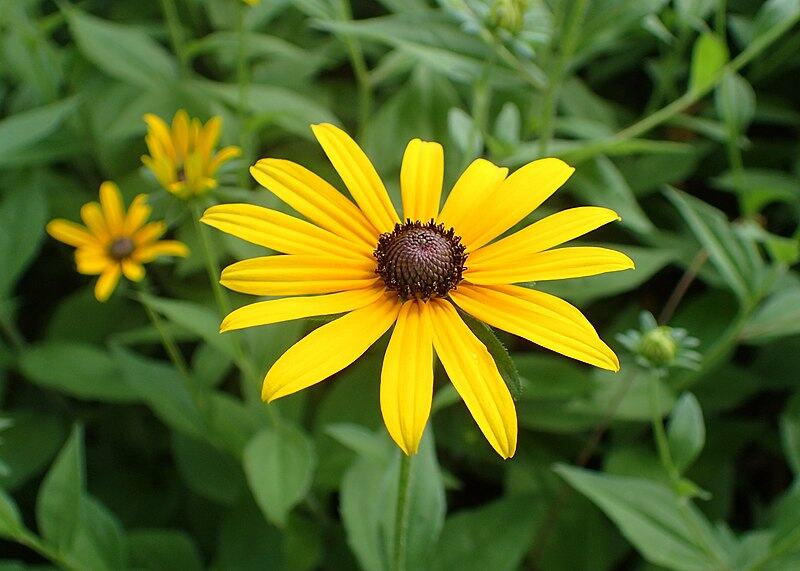
Photo Credit: Krzysztof Ziarnek, Kenraiz / Wikimedia Commons / CC BY-SA 4.0
Black-eyed Susan is a flowering plant known for its bright yellow petals and dark brown center. It typically grows to a height of 1 to 3 feet and blooms during spring, summer, and early autumn. Black-eyed Susan is often grown as an ornamental plant in cottage and butterfly gardens and landscapes. It is also an essential source of pollen and nectar for pollinators.
While Black-eyed Susan is generally a hardy plant, it can be vulnerable to powdery mildew, slugs and snails.
Plant type: Flower
USDA Hardiness Zone: 3 to 9
Sun: Full sun
Soil: Clay, sand, loam, acidic, moist, well-drained
Duration: Depending on growing conditions can act as a biennial, annual, or short-lived perennial
Fragrance: Sweet
Bloom time: Spring, summer, early autumn
Water needs: Medium. It has moderate drought tolerance
Mature height: 1 to 3 feet.
Maintenance: Low. Can self-seed freely. Black-eyed Susan can become aggressive if given too perfect an environment and insufficient competition.
3. Virginia Bluebells (Mertensia virginica)
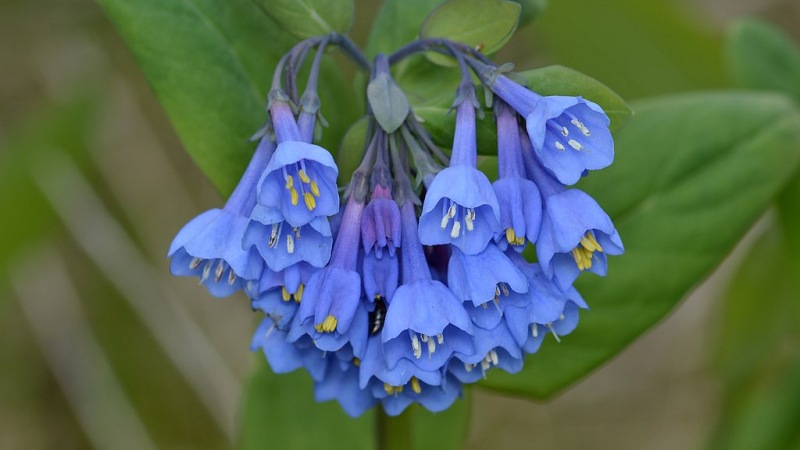
Photo Credit: Ryan Hodnett / Wikimedia Commons / CC BY-SA 4.0
Virginia bluebells is a herbaceous perennial plant that produces clusters of bell-shaped flowers that are pink in bud and then gradually turn to a beautiful sky blue color. The flowers bloom in early spring and attract pollinators such as bees and butterflies.
It grows from seeds in the fall, overwinters as small rosettes of leaves, and then rapidly grows and flowers in the spring before going dormant in the summer. The plant spreads by self-seeding and can form large colonies over time.
Plant type: Herbaceous
USDA Hardiness Zone: 3 to 8
Sun: Part shade to full shade
Soil: Chalk, clay, loam, sand. Acid, alkaline, neutral. Moist but well-drained
Duration: Perennial
Fragrance: Light, sweet
Bloom time: Spring
Water needs: Average. It does its best when moisture is abundant and will decline when the soil is too dry
Mature height: 1 to 2 feet
Maintenance: Medium. This plant self-seeds, but is not easy to propagate. It should be cut back after flowering.
4. Wild Geranium (Geranium maculatum)
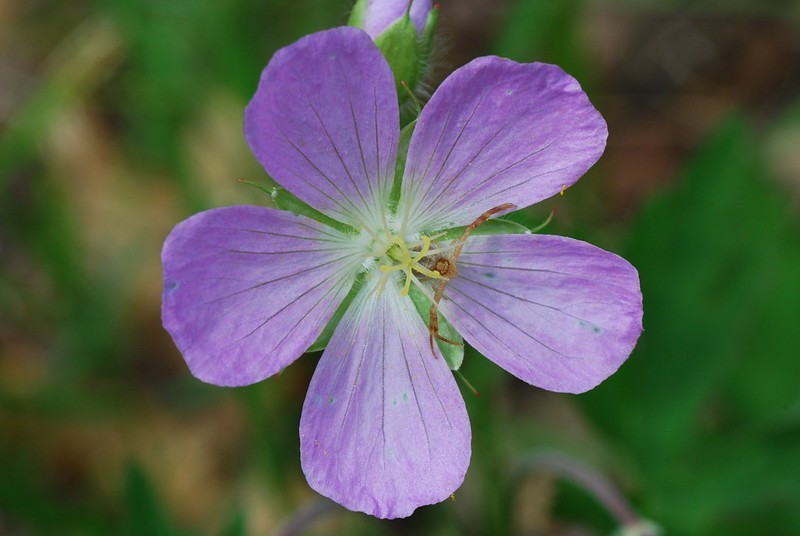
Photo Credit: Joshua Mayer / Flickr / CC BY-SA 2.0
Wild geranium is a herbaceous perennial plant known as wood geranium, spotted geranium, or cranesbill. It typically grows 1 to 2 feet tall and produces showy, five-petaled, pinkish-purple flowers in late spring to early summer. Its leaves are deeply lobed.
It is a popular garden plant and is often used as a ground cover due to its ability to spread through rhizomes. Ground covers help to prevent soil erosion, outcompete and suppress the growth of weeds, and help to retain moisture in the soil.
Plant type: Clump-forming flowering plant
USDA Hardiness Zone: 3 to 8
Sun: Full sun to part shade
Soil: Chalk, clay, loam, sand. Acid, alkaline, neutral. Moist but well-drained.
Duration: Semi-evergreen perennial
Fragrance: Citrus and fruity accents with a hint of rose smell
Bloom time: Late spring, early summer
Water needs: Medium. Recently planted geraniums should be kept in moist soil during the first growing season.
Mature height: 1 to 2 feet
Maintenance: Low. Remove flower stems and old leaves to encourage the production of new leaves and flowers.
5. Wild Columbine (Aquilegia canadensis)
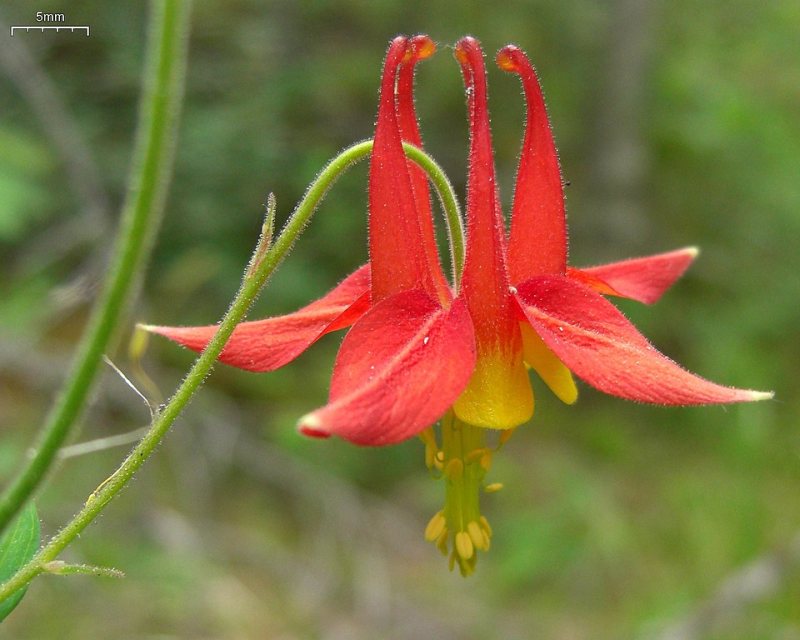
Photo Credit: Jason Hollinger / Wikimedia Commons / CC BY 2.0
Wild columbine is a beautiful wildflower that grows 2 to 3 feet tall and has distinctive, bell-shaped flowers with red and yellow petals. The leaves of wild columbine are delicate and fern-like, and the flowers are borne on long, thin stalks that rise above the foliage. Because of their nectar, the flowers attract bees, butterflies, and hummingbirds.
Plant type: Herbaceous
USDA Hardiness Zone: 3 to 8
Sun: Full sun to part shade
Soil: Chalk, clay, loam, sand. Acid, alkaline, neutral. Moist but well-drained.
Duration: Semi-evergreen perennial
Bloom time: Late spring, early summer
Water needs: Average. It prefers moist soil, so don’t let the soil dry out.
Mature height: 1 to 3 feet
Maintenance: Medium. Be careful of overwatering in summer because the crowns can rot. Remove faded flowering stems to promote additional bloom.
6. New England Aster (Symphyotrichum novae-angliae)
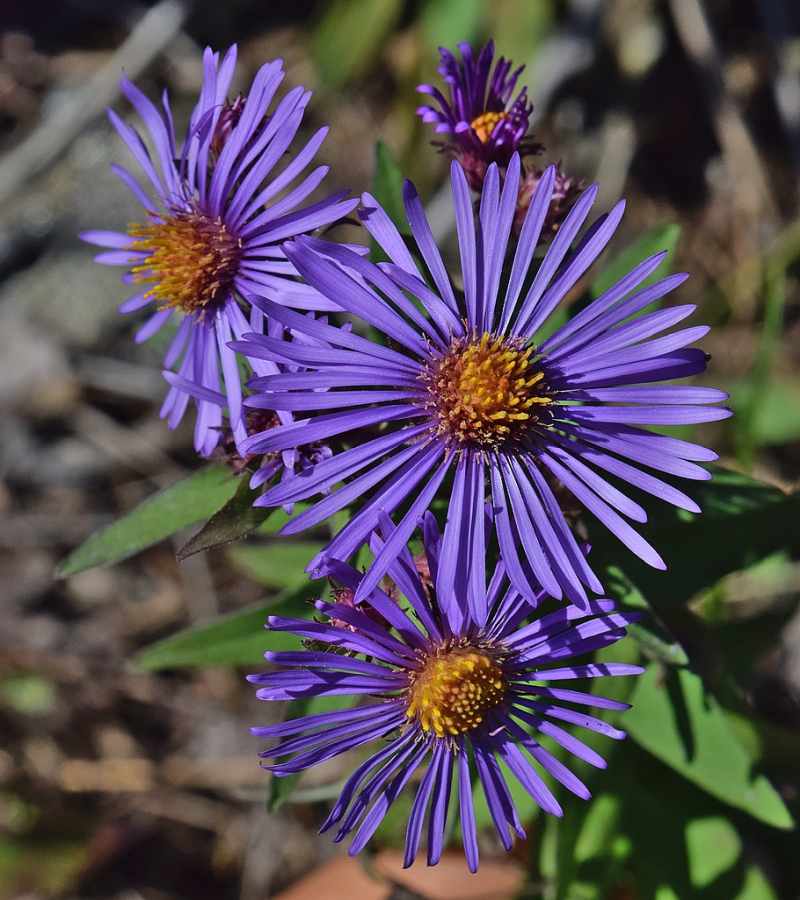
Photo Credit: The Cosmonaut / Wikimedia Commons / CC BY-SA 2.5 CA
The New England aster is a perennial herbaceous plant that grows up to 6 feet tall and has numerous purple, pink, or violet flowers with yellow centers. The plant blooms in late summer to fall, making it a valuable late-season food source for bees and other pollinators. The New England aster is a beautiful and beneficial plant for its aesthetic and ecological qualities.
New England aster can be susceptible to powdery mildew and aster wilt. To prevent aster wilt, it is important to plant New England aster in well-drained soil and avoid overwatering.
Plant type: Herbaceous flower
USDA Hardiness Zone: 4 to 8
Sun: Full sun, partial shade
Soil: Chalk, clay, loam, sand. Acid, alkaline, neutral. Moist but well-drained
Duration: Deciduous perennial
Bloom time: Late summer, autumn
Water needs: Medium. It prefers medium moisture, well-drained soil.
Mature height: 3 to 6 feet
Maintenance: Medium. If the plant is tall, it may require staking or other support. Pinch back stems before midsummer to promote bushiness, produce more flowers, and control the plant height.
7. Butterfly Weed (Asclepias tuberosa)
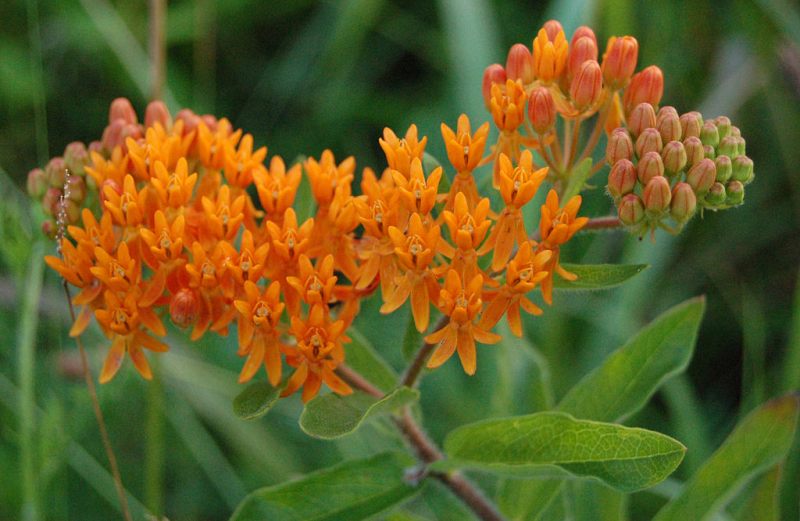
Photo Credit: Photo by Derek Ramsey (Ram-Man) / Wikimedia Commons / CC BY-SA 2.5
Butterfly weed is a perennial herb that can grow up to 3 feet tall and produces clusters of bright orange or yellow flowers in the summer. The plant gets its name from its ability to attract a wide variety of butterflies, which are attracted to the nectar produced by its flowers.
Butterfly weed is relatively easy to grow but requires well-drained soil and full sun. Butterfly weed is essential to monarch butterfly survival; planting it in your garden can help preserve this beautiful insect.
Plant type: Herbaceous flower
USDA Hardiness Zone: 3 to 9
Sun: Full sun
Soil: Clay, loam, sand. Acid, neutral. Prefers well-drained sandy soils. Performs well in poor, dry soils.
Duration: Deciduous perennial
Fragrance: Sweet, vanilla, candy-like fragrance.
Bloom time: Late spring, summer.
Water needs: Low. It thrives in dry to moist, well-drained soils. Tolerates drought.
Mature height: 1 to 2 feet
Potential hazards: Toxic to pets, livestock, and people when ingested
Maintenance: Low. Plants can grow fast from seed but are slow to establish and may take 2 to 3 years to produce flowers.
8. American Holly (Ilex opaca)
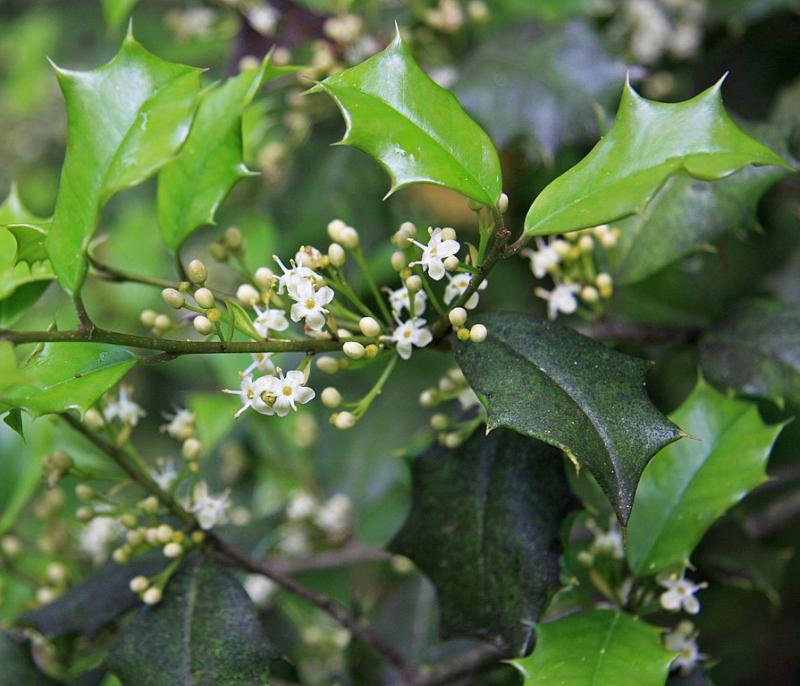
Photo Credit: Dcrjsr / Wikimedia Commons / CC BY 3.0
American holly is a species of evergreen tree known for its glossy green leaves, which are often used in holiday decorations. It can grow up to 50 feet tall and produces small, white flowers during spring. Bright red berries follow flowers in the fall and winter. American holly provides food for many species of birds, including cedar waxwings, robins, and blue jays. In contrast, the dense foliage provides shelter for animals such as deer and rabbits.
It is a slow-growing tree that requires well-drained soil and full sun to partial shade. It can be prone to insect pests like holly leaf miners, spider mites, whitefly, and scale. It may also suffer from diseases like leaf spots, rot, tar spot, and powdery mildew, causing leaf discoloration, wilting, and overall decline. Proper care and maintenance are essential to keep it healthy.
Plant type: Tree
USDA Hardiness Zone: 5 to 9
Sun: Full sun, partial shade
Soil: Chalk, clay, loam, sand. Acid, neutral. Moist but well-drained.
Duration: Evergreen perennial
Fragrance: Sweet
Bloom time: Spring and early summer
Water needs: Medium. It will occasionally tolerate wet or dry soil but not flooding. For optimum growth, avoid poorly drained soils.
Mature height: 15 to 30 feet. In moist regions, it can occasionally approach up to 60 feet.
Potential hazards: It may be toxic if ingested by people, cats, or dogs. Children are most vulnerable because of their curiosity and small size.
Maintenance: Low. Supplemental water may be necessary for drier sands.
9. Marsh Blazing Star (liatris spicata)
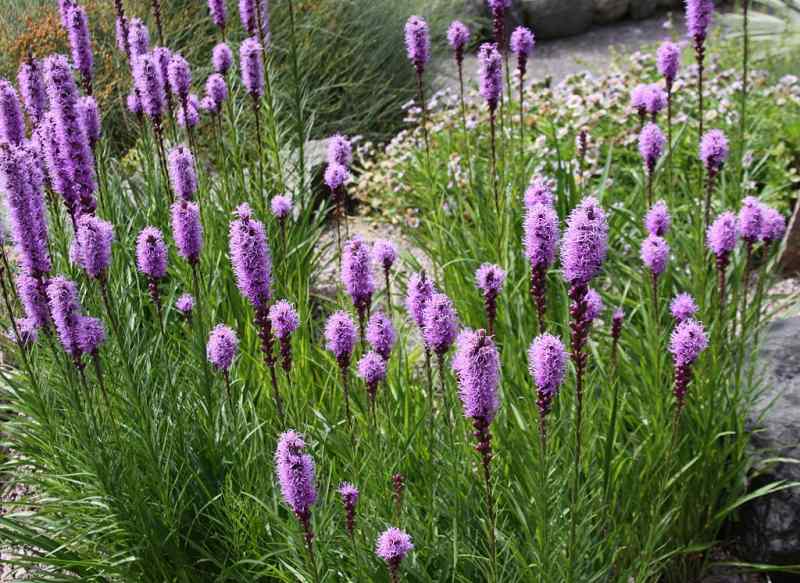
Photo Credit: Drew Avery / Wikimedia Commons / CC BY 2.0
Marsh blazing star is a herbaceous perennial commonly known as dense blazing star or button snakeroot. It produces tall spikes of pink to purple flowers in the summer, highly attractive to bees, butterflies, and other pollinators.
The plant grows to a height of 2 to 5 feet and has narrow, grass-like leaves that grow up from the base of the plant. It is relatively low-maintenance and easy to grow from seed or transplants. It can tolerate a wide variety of soil types.
Plant type: Herbaceous flowering plant
USDA Hardiness Zone: 3 to 8
Sun: Full sun
Soil: Chalk, clay, loam, sand. Acid, alkaline, neutral. Moist but well-drained.
Duration: Deciduous perennial
Fragrance: Faint smell of vanilla
Bloom time: Summer
Water needs: Medium. Intolerant of wet soils in winter.
Mature height: 3 to 6 feet
Maintenance: Low. Tall plants may need staking or other support.
10. Aromatic Aster (symphyotrichum oblongifolium)
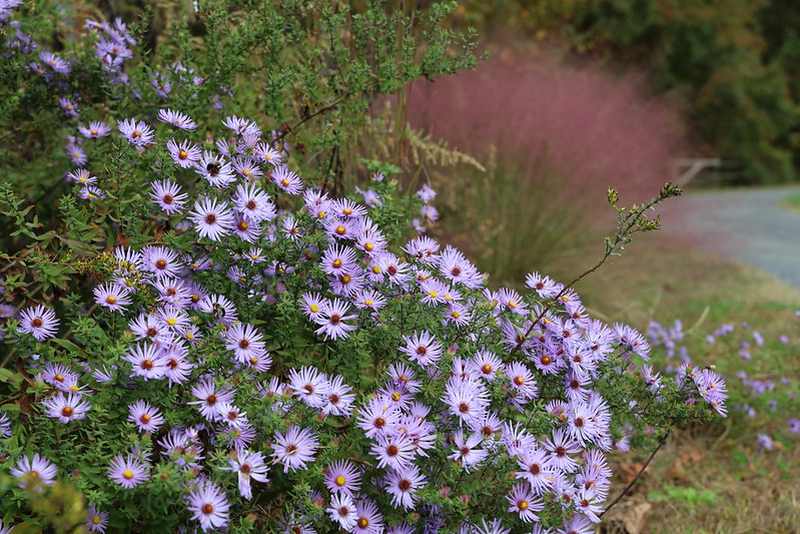
Photo Credit: Lydia Fravel / Flickr / CC BY 2.0
Aromatic aster is a herbaceous perennial that produces clusters of small, daisy-like flowers in the late summer and fall, which range in color from pale blue to violet. The plant grows to a height of 1 to 3 feet and has narrow, lance-shaped leaves that are highly aromatic when crushed.
In addition to its beauty, aromatic aster is valued for its ecological value. It is an important nectar source for pollinators, and its seeds are eaten by many species of birds.
Plant type: Herbaceous flower
USDA Hardiness Zone: 3 to 8
Sun: Full sun
Soil: Clay, loam, sand. Alkaline, neutral, acidic soil. Well-drained.
Duration: Deciduous perennial
Fragrance: Balsam-like aroma when flowers are crushed
Bloom time: Late summer, autumn
Water needs: Low. It can tolerate drought
Mature height: 1 to 3 feet
Maintenance: If the plant gets top-heavy, you can keep it thick by pruning it back by no more than half in June. After it goes dormant, wait to cut back to the basal rosette in late fall or early winter. Some support may be needed for taller plants.
11. Black Birch (betula nigra)
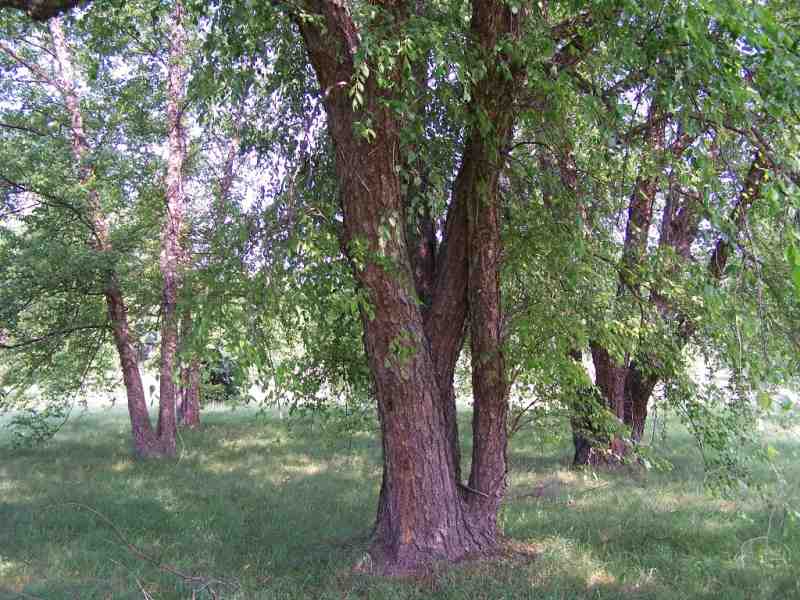
Photo Credit: Bruce Marlin / Wikimedia Commons / CC BY-SA 2.5
Black birch can grow up to 80 feet tall, with a trunk diameter of up to 3 feet. Black birch is known for its distinctive black, scaly bark that peels off in thin, curly strips. The leaves are dark green and oval-shaped with a pointed tip.
In the fall, leaves change their color to a beautiful golden-yellow tone. The tree produces catkins in the spring, clusters of tiny flowers hanging from the branches. These flowers are an essential food source for bees and other pollinators.
Plant type: Tree
USDA Hardiness Zone: 4 to 9
Sun: Full sun to partial shade
Soil: Chalk, clay, loam, sand. Acid, alkaline, neutral. Moist but well-drained.
Duration: Deciduous perennial
Fragrance: The inner bark of the tree has a strong wintergreen scent
Bloom time: Spring
Water needs: Medium. Perform best in moist soils. The use of soaker hoses and bark mulches keeps the roots moist.
Mature height: 40 to 70 feet
Maintenance: Low. It needs little pruning. It tends to drop a lot of twigs, making it better suited for rustic areas of the landscape.
How to Choose Native Plants for Your Pittsburgh Yard
Growing native plants in the landscape and garden can help support local biodiversity, reduce water usage, and create a beautiful and sustainable landscape. However, not all native plants are suitable for your garden, be sure to select plants suitable for the soil, sun exposure, and watering capabilities of your backyard.
Pittsburgh sits in USDA Hardiness Zone 6, indicating cold winters and warm summers. Keep your zone in mind when selecting non-native plants for your landscape.
FAQ About Native Pittsburgh Plants
What’s the difference between native plants and non-native plants?
A native plant is a species that naturally occurs and evolves in a specific geographic region or ecosystem. They are adapted to that region’s climate, soil, and other environmental conditions and have often co-evolved with local wildlife. They are essential to a healthy ecosystem.
In contrast, a non-native species is a plant that has been brought from another part of the world. These plants can negatively impact the environment, out-competing native plants, reducing biodiversity, and altering the ecological processes of the ecosystem.
What plants are illegal in Pennsylvania?
The Pennsylvania Department of Agriculture has included Ravenna grass, glossy buckthorn, and common buckthorn in a list of noxious weeds. These plants cannot be legally sold or grown in the state.
Can I gather native plants from the wild?
It’s not recommended to gather native plants from the wild, and in some cases, you aren’t legally permitted to. Transporting native plants is a delicate process, so experts recommend that you purchase them from a nursery certified in dealing with and handling native plants.
What other plants are native to Pennsylvania?
Other native plants of Pennsylvania include:
- Pennsylvania Sedge
- Swamp Milkweed
- Wild Bergamot
- Canada Goldenrod
- Cardinal Flower
- Heartleaf Foamflower
Where to Find Native Plants in Pittsburgh
If you want to enrich your Pittsburgh backyard with native plants, there are several places you can find them; local nurseries, garden centers, online nurseries, and seed companies, for example.
Check out these plant nurseries recommended by the Native Plant Society of Pennsylvania:
Considering native plants as the main beauty of your garden is one step closer to a final landscaping design project. Be sure to consider low-maintenance landscaping ideas and the best grass types for Pittsburgh for a healthy lawn.
If you would like to have a beautiful backyard lawn and need the help of a professional, connect with a local lawn care pro in your area.
Main Photo Credit: Phipps Conservatory, Pittsburgh / GPA Photo Archive / Flickr / CC BY 2.0